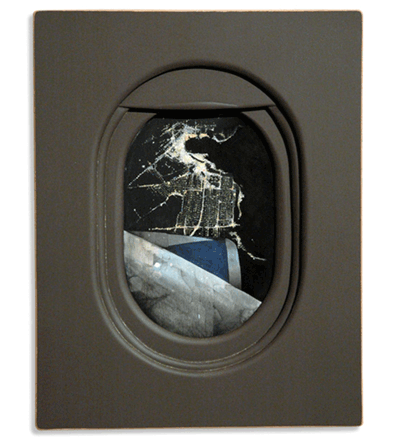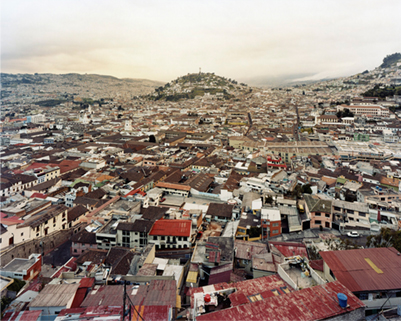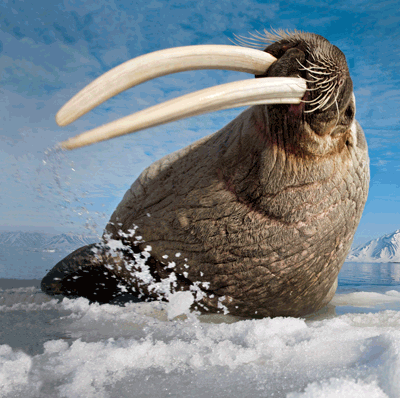
Thrill Jockey Records

The best way to listen to
Peer Amid, the latest album from Swedish noise-makers the Skull Defekts, is to simultaneously stare at the album cover. The image is a road map for a record that begins with a sustained mystic Eastern chant, awakening a lumbering bass line that explodes into a chorus of Steve-Albini-esque guitar noise. The rest of
Peer Amid follows a similar pattern, creating a dense song cycle of industrial destruction with former Lungfish singer Daniel Higgs at the center. Higgs’ presence on
Peer Amid, his first collaboration with the Defekts, will likely draw many new listeners, but aside from a few shared sections of a Venn diagram, don’t expect many similarities between this album and anything produced by Higgs’ former band.
Each song is built around a propulsive and repeating rhythm that seamlessly morphs between songs for an effect that’s less punk and more hypnotically psychedelic. Jarring guitars and multi-layered tribal drumming are built on top of prominent bass-lines, with suites of distortion buttressing all the rhythmic chaos.

Audio clip: Adobe Flash Player (version 9 or above) is required to play this audio clip. Download the latest version here. You also need to have JavaScript enabled in your browser.
Buy this at Other Music or iTunes.
(more…)

When the Killing's Done cover image/ courtesy: Viking

In his latest novel, T. Coraghessan Boyle considers the real life story of the National Park Service’s systematic slaughter of wild animals. To be clear, the species in question at the center of When the Killing’s Done are the invasive rats and non-native pigs whose presence has disrupted the ecological balance on Anacapa and Santa Cruz, two of the Channel Islands off the Southern Californian coast. Getting rid of these pests, according to the argument presented by the Park Service, would enable a return to the conditions as nature intended, before the arrival of sheep herders and shipwrecked gold prospectors introduced the undesirable creatures in the first place and set off a chain of habitat-altering ramifications.
Using this highly contentious campaign to frame the story, Boyle constructs a fictional tale of characters touched by the arguments over which lives are worth saving and just when it is reasonable to play God. Alma Boyd Takesue, the good-intentioned Park Service biologist who supports the extermination process, is pitted against the hotheaded and dreadlocked animal rights activist Dave LaJoy and his band of perfervid followers. The battle lines are drawn, the passions are intense, and nearly everyone, no matter their position on the killing, is out for blood.
Animals verses animals, humans taking on animals, and finally, humans up against humans – the conflicts presented here make this only the latest in Boyle’s literary explorations of the complexities present where fights over nature occur.
(more…)


Painter and Designer Jim Darling has a fresh take on the view from an airplane window. His six paintings, display the classic airplane window complete with pull down shade, rendered in a classic trompe d’oeil technique of the old masters. However within the window are wonderfully abstracted scenes capture the essence of patchy farmlands, nighttime aerials of lit cities and skylines. Darling’s graphic design background includes work with MTV, Coor’s light and Cambell’s Chicken noodle soup, each picture strongly rooted in his ability to draw. His illustrative mastery and graphic have pulled together in these fun oil on wood panels. The airplane series is part of a larger collection exhibited at Open Space in Beacon NY. Other paintings in the collection are themed with aircraft flight, and include a few humorous yet artful caricatures of passengers. Jim Darling definitely has created a spirited way of looking at the world.
(more…)

Razor & Tie

Nicole Atkins leaves a big impression. Her powerful lung capacity, her barreling backbeat, her blustery presence, none of these indicates a shrinking violet. On her second solo full-length,
Mondo Amore, Atkins veers towards elaborate arrangements and layered instrumentation to showcase her Roy Orbison-meets- Carole King delivery. This is a mainstream step away from the torch singing of her previous album,
Neptune City. Atkins may have taken this step to bring more attention to her striking vocal prowess — and she can certainly pull it off — but it is the smoldering burn of
Neptune City that sets Atkins apart. The smoke of
Neptune only occasionally seeps out, on the billowing “Hotel Plaster”, which shifts easily into the gravelly crunches of “You Come To Me”. On the flip side, Atkins’ vigorous belting out of the trite lyrics to “This Is For Love” makes them sound novel while in contrast, “The Tower” is all bluster with no substance. Instead of playing it safe, which is what Atkins does on the majority of
Mondo Amore, she should focus on one instrument: her undeniable voice.
Buy this at
iTunes. After the jump, check out the video for “Vultures”.
(more…)

La Merced, Quito, 2010. Courtesy Yossi Milo Gallery, New York (Click for Slideshow)

Cities have a power that’s highly impressionistic. More often than not, what we remember best about the ones we’ve visited isn’t the famous monuments but the mood of particular neighborhoods and streets.Sze Tsung Leong’s series of photographs “Cities,” on display now at Yossi Milo Gallery, consists of big, bird’s-eye views of different cities around the globe. In capturing the organization, architecture and geography of each metropolis, they go a long way to convey the character of these places.
Most of Leong’s photographs don’t fall into easy postcard views. They’re elegantly composed but richly textured and shadowed so that they have an impressive tactility. And they have a greater depth and angle of vision, so that they take in broader stretches than a typical cityscape. It’s a point of view that reveals some of the historic and technological forces that have shaped each place. In Ghent the low, twisting streets around the Medieval Cathedral give way to square blocks with modern commercial buildings. And in Cairo satellite antenna sprout from the debris-strewn roofs of dusty concrete apartment buildings.
Click for Slideshow
(more…)


The late Fritz Goro inventor of macro photography saw his goal as “making visible the world that lies between the microscope and the naked eye.” Turning to photography after the Nazi’s forced him out of Germany, Fritz Goro started a career with LIFE Magazine, shooting scientific photoessays and was the magazine’s scientific and medical specialist for twenty-seven years. Fritz Goro photographed many scientific breakthroughs and discoveries including the creation of penicillin as well as the separation of the isotopes of uranium and plutonium that made the atomic bomb. Chairman of the board of Scientific American, then science editor at Life Mr. Gerard Piel said of Goro, ”it was his artistry and ingenuity that made photographs of abstractions, of the big ideas from the genetic code to plate tectonics.” Fritz Goro’s legacy lives on in the beautiful geometric black and white images of America’s biggest scientific breakthroughs of the twentieth century.
(more…)

In this picture publicly provided by the German aerospace DLR and their crisis center on Monday March 14, 2011 the Japanese city of Sendai is pictured on Saturday March 12, 2011 after the earthquake and the following tsunami. (AP Photo/DLR ZKI)

Since the strike of an 8.9 magnitude earthquake east of Sendai, Japan at 2:46 PM local time last Friday, the rest of the world has been watching in horror as one catastrophe has unfolded upon another. A devastating tsunami striking Japan’s northeastern coast, then growing concerns about the possible release of radioactivity from six nuclear reactors whose cooling systems were disrupted by the quake, all adding up to the worst destruction the country has seen in 65 years. The vast extent of the damage has revealed itself as rescuers move into the affected areas. Estimates early in the week place the number of casualties above 10,000, with 500,000 said to have been displaced.
The crisis continues to play out, with the nuclear failure possibly the most serious front of all, but mercifully, humanitarian efforts are already under way in some areas. To supplement Japan’s own considerable response actions, the United States quickly deployed naval rescue vessels to the Japanese coast, including the USS Ronald Regan, carrying relief supplies and manpower in an effort that’s being called “Operation Tomodachi,” which is Japanese for “friendship.” The U.S. Agency for International Development (USAID) has sent search and rescue teams and disaster response units of its own.
(more…)

By Paul Nicklen Courtesy of The Annenberg Foundation (Click to see full Image)

Some photos are harder to come by than others. The average paparazzo will tell you that much. But capturing the rarest of images can often put a photographer’s very life in jeopardy. Far trickier than snapping the picture of an unsuspecting celebrity from the other end of the beach with a telephoto lens are the shots taken in more demanding environments with even wilder species set in the middle of the frame.
Prints from an assortment of nature and wilderness photographers are on display at the
Annenberg Space for Photography in Los Angeles through April 17, and what the pictures all have in common is that they were perilously difficult to take. Risking the loss of life and limb in bone-chilling Antarctic waters, gator-infested swamplands, disease-ridden jungles, or at the site of erupting volcanoes, the lensmen responsible for these images managed to come away with photographic evidence of scenes rarely observed by the human eye.
(more…)





 Facebook
Facebook Permalink
Permalink Digg
Digg Reddit
Reddit LinkedIn
LinkedIn StumbleUpon
StumbleUpon Tumblr
Tumblr












